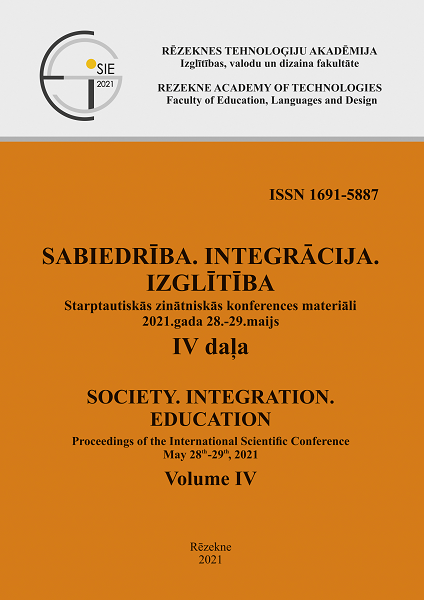PATIENTS NEED TO RECEIVE THE SAME KIND OF INFORMATION ABOUT THE SAME ISSUE FROM EACH PROFESSIONAL
DOI:
https://doi.org/10.17770/sie2021vol4.6405Keywords:
HIV, perinatal period, received informationAbstract
The questionnaire has been developed from a validated instrument “Women’s Experience of Maternity Care” (author - National Health Service, (Great Britain, 2019) and adapted to the situation in Latvia. The permission to use it has been obtained from authors. The questionnaire is meant for women regardless of their health status during the perinatal period or who have no co-morbidities, diagnosed in perinatal period of care. The questionnaire is designed to find out patients' experiences of receiving healthcare and its compliance with the guidelines, identifying potential problems and creating opportunities to correct them. There were 50 patients in Maternity Hospital postpartum unit interviewed. 12 of them were women living with HIV. Results. One of five main comment themes was - patients felt the need to receive the same kind of information about the same issue from all health care professional regardless of staff changes on call. The women point out that they have no problems with content in communication process during intranatal period, at labor unit. The problem with different kind of information about the same matter is emerging in postpartum period, at maternity unit. This issue is bothering both groups of patients in postnatal period, those women who live with HIV and those who have no co-morbidities, diagnosed in perinatal period. This shows that there is different kind of knowledge and professional skills among health care professionals, even if they work in the same field, the same hospital and the same unit. There should be done more research to identify the source of this problem. Is it the different experience, knowledge, informational field where professionals seek for information or totally different reason for this phenomena.
Downloads
References
ACOG. (2012). Maternity care Performance Measurement. Retrieved from https://www.ahrq.gov/sites/default/files/wysiwyg/CHIPRA-BMI-Maternity-Care-Measures.pdf
Afulani, P. A., Buback, L., Kelly, A. M., Kirumbi, L., Cohen, C. R., & Lyndon, A. (2020). Providers’ perceptions of communication and women’s autonomy during childbirth: a mixed methods study in Kenya. Reproductive Health, 17, 1-17. https://doi.org/10.1186/s12978-020-0909-0. Retrieved from https://search-proquest-com.db.rsu.lv/docview/2414808395?pq-origsite=primo
Aigbe, A. O. (2014) Poviders’ Perspectives on Bariers to care, System Constraints and piloting the HIV-modified centering Pregnancy Model among HIV-positive pregnant women. Research Gate. Retrieved from https://digitalcommons.library.tmc.edu/dissertations/AAI3665069/
Beaton, D. E., Bombardier, C., Guillemin, F., Bosi Ferraz, M. (2000) Guidelines for the Process of Cross-Cultural Adaptation of Self-Report Measures, PMID: 11124735 DOI: 10.1097/00007632-200012150-00014 Retrieved from https://pubmed.ncbi.nlm.nih.gov/11124735/
DeBaets, A. M. (2017). From birth plan to birth partnership: enhancing communication in childbirth. American journal of obstetrics and gynecology, 216(1), 31-e1. Retrieved from https://www-sciencedirect-com.db.rsu.lv/science/article/pii/S0002937816308080?via%3Dihub
E-veseliba. (2019)., “Vai Tu zini visu par HIV?” Retrieved from https://www.eveseliba.gov.lv/sakums/informativie-raksti/reproduktiva-veseliba/seksu%C4%81li-transmis%C4%ABv%C4%81s-slim%C4%ABbas/vai-tu-zini-visu-par-hiv
GINASOC. (2020). Vadlīnijas un rekomendācijas dzemdību speciālistiem. Retrieved from https://www.ginasoc.lv/kliniskas-rekomendacijas-2
Graham, W. J. (2009). Criterion-based clinical audit in obstetrics: bridging the quality gap? Best practice & research Clinical obstetrics & gynaecology, 23(3), 375-388. Retrieved from https://europepmc.org/article/med/19299203
Kamiński, M., Łoniewski, I., & Łoniewska, B. (2020). ‘Dr. Google, is caesarean section good for me?’–the global Internet searches associated with mode of birth methods: Retrospective analysis of Google trends data. Midwifery, 89, 102787.
Lyndon, A., Johnson, M. C., Bingham, D., Napolitano, P. G., Joseph, G., Maxfield, D. G., & O'Keeffe, D. F. (2015). Transforming communication and safety culture in intrapartum care: A multi‐organization blueprint. Journal of Obstetric, Gynecologic & Neonatal Nursing, 44(3), 341-349. Retrieved from https://www-sciencedirect-com.db.rsu.lv/science/article/abs/pii/S0884217515318128
Madula, P., Kalembo, F. W., Yu, H., & Kaminga, A. C. (2018). Healthcare provider-patient communication: a qualitative study of women’s perceptions during childbirth. Reproductive health, 15(1), 1-10. https://doi.org/10.1186/s12978-018-0580-x, Retrieved from https://search-proquest-com.db.rsu.lv/docview/2089764180?pq-origsite=primo
Malouf, R., Henderson, J., & Redshaw, M. (2017). Access and quality of maternity care for disabled women during pregnancy, birth and the postnatal period in England: data from a national survey. BMJ open, 7(7), e016757. Retrieved from https://bmjopen.bmj.com/content/7/7/e016757
Matzke, B., Houston, S., Fischer, U., & Bradshaw, M. J. (2014). Using a team‐centered approach to evaluate effectiveness of nurse–physician communications. Journal of Obstetric, Gynecologic & Neonatal Nursing, 43(6), 684-694. Retrieved from https://www-sciencedirect-com.db.rsu.lv/science/article/abs/pii/S0884217515316099
Mukherjee, S., Fennie, K., Coxe, S., Madhivanan, P., & Trepka, M. J. (2018). Racial and ethnic differences in the relationship between antenatal stressful life events and postpartum depression among women in the United States: does provider communication on perinatal depression minimize the risk? Ethnicity & health, 23(5), 542-565. https://doi.org/10.1080/13557858.2017.1280137. Retrieved from http://web.a.ebscohost.com.db.rsu.lv/ehost/pdfviewer/pdfviewer?vid=1&sid=925b6e46-ffe1-467a-a698-103596cb5c3a%40sdc-v-sessmgr03
Nathan, A. T. & Kaplan, H. C. (2017). Tools and methods for quality improvement and patient safety in perinatal care. Elsevier, PMID: 28552386 DOI: 10.1053/j.semperi.2017.03.002 Retrieved from https://pubmed.ncbi.nlm.nih.gov/28552386/
NHS. (2019). Women’s Experience of Maternity Care. Retrieved from https://www.cqc.org.uk/sites/default/files/20200128_mat19_technicaldocument.pdf
SPKC. (2017). Piemērotsuzturs, plānojot grūtniecību un grūtniecības laikā, —veselīga dzīves sākuma pamats. Retrieved from https://www.spkc.gov.lv/lv/ieteikumi-veselibas-aprupes-specialistiem-piemerots-uzturs-planojot-grutniecibu-un-grutniecibas/ieteik_prof_grutn1.pdf
Tunçalp, Ӧ., Were, W. M., MacLennan, C., Oladapo, O. T., Gülmezoglu, A. M., Bahl, R., ... & Bustreo, F. (2015). Quality of care for pregnant women and newborns—the WHO vision. BJOG: an international journal of obstetrics & gynaecology, 122(8), 1045-1049.
VM. (2020). HIV infekcija. Retrieved from https://www.spkc.gov.lv/lv/hiv-infekcija
VM. (2014). Vecmātes profesijas standarts, 13., 27. pants. Retrieved from http://www.vecmasuasociacija.lv/wp-content/uploads/Standrt.apstipr..pdf
VM. (2017). ”HIV infekcijas, seksuālās transmisijas infekciju, B un C hepatīta izplatības ierobežošanas rīcības plāns 2018. - 2020.gadam”. Retrieved from https://likumi.lv/ta/id/294753-par-hiv-infekcijas-seksualas-transmisijas-infekciju-b-un-c-hepatita-izplatibas-ierobezosanas-ricibas-planu-2018-2020-gada
WHO. 92016). Mission to assess readiness for validation of the elimination of mother to child transmission of HIV. Retrieved from https://www.euro.who.int/en/countries/latvia/publications/mission-to-assess-readiness-for-validation-of-the-elimination-of-mother-to-child-transmission-of-hiv-latvia,-23-27-may-2016
WHO. (2016). Standards for improving quality of maternal and new-born care in health facilities. Retrieved from https://www.who.int/maternal_child_adolescent/documents/improving-maternal-newborn-care-quality/en/
WHO. (2007). Standards for Maternal and Neonatal Care. Retrieved from https://www.who.int/reproductivehealth/publications/maternal_perinatal_health/a91272/en/
WHO. (2016). WHO recommendations on antenatal care for a positive pregnancy experience. Retrieved from https://www.who.int/publications/i/item/9789241549912
WHO. (2013). WHO recommendations on postnatal care of the mother and new-born. Retrieved from https://www.who.int/maternal_child_adolescent/documents/postnatal-care-recommendations/en/
WHO. (2018). WHO recommendations: intrapartum care for a positive childbirth experience. Retrieved from https://www.who.int/reproductivehealth/publications/intrapartum-care-guidelines/en/
Yu, M., Lee, H. Y., Sherwood, G., & Kim, E. (2018). Nurses' handoff and patient safety culture in perinatal care units: Nurses' handoff evaluation and perception of patient safety culture at delivery room and neonatal unit in South Korea. Journal of clinical nursing, 27(7-8), e1442-e1450.


